

Chapter 1: RSW16 bicycle—From Cycle to
Moped
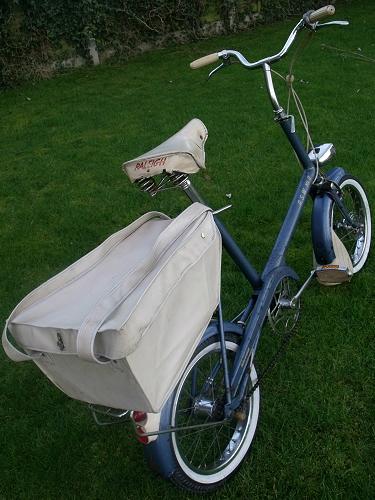
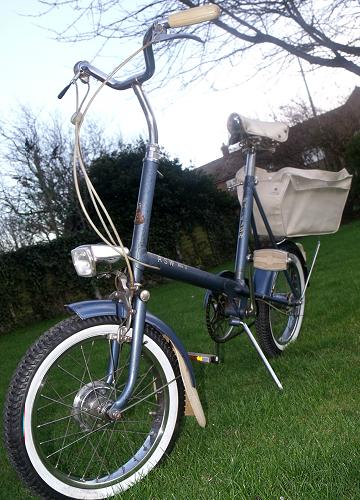 This tale has to start
with a chap called Alex Moulton, an aircraft engineer, who came
up with designs in the late 1950s to produce small-wheeled
bicycles. He approached Raleigh with the idea, but
negotiations broke down, so he formed his own company as Moulton
Bicycles Ltd and established a factory at Bradford-on-Avon,
to begin building bicycles himself.
This tale has to start
with a chap called Alex Moulton, an aircraft engineer, who came
up with designs in the late 1950s to produce small-wheeled
bicycles. He approached Raleigh with the idea, but
negotiations broke down, so he formed his own company as Moulton
Bicycles Ltd and established a factory at Bradford-on-Avon,
to begin building bicycles himself.
The original Moulton Bicycle was launched in 1962 at the Earls
Court Cycle Show, and presented as a fresh new approach to
cycling design. It proved the right product at the right
time, quickly being adopted as an icon of the
‘swinging-’60s’, and a fashionable mini-bike to
go with mini-skirts and mini cars.
Within a year, Moulton Bicycles had become the second-largest
frame builder in the country, of which Raleigh, as leading
supplier, was now only too aware. Having seen the roaring
success of the Moulton small-wheel cycle, Raleigh now felt the
pressure to come up with another small-wheel cycle design that
wouldn’t infringe any of the Moulton patents. A
Raleigh Small Wheel 16 pre-production model was shown to Alex
Moulton as early as 1964, to go on sale in 1965 as the RSW16, and
differing from the Moulton enough in the critically patent
covered aspects to get away with the design.
Both cycle types had a similar appearance with open-style
frames and carrying capacity.
Moulton employed small diameter wheels of thin section to
reduce frictional resistance, and used suspension to soften its
ride. The Raleigh had a rigid frame, using instead a new
16×2 ‘balloon’ tyre to give a suspension
effect, though at the cost of greater drag and effort to the
rider. The Moulton was more efficient, but the RSW16 came
at a cheaper price and looked the part, so it began to capture
sales back from Moulton.
The RSW16 evolved through a number of changes and different
mark models. Initially introduced in two metallic colours,
green and bronze (red), with a round chrome-plated headlight
mounted on the front mudguard, and calliper rear brake. The
RSW also introduced the twistgrip gear-change selector, mounted
on the right hand bar in the manner of a motor cycle throttle,
with gear position shown by an indicator.
More colour options were added to the range, along with a
stowaway RSW ‘Compact’ version with fold-down
handlebars and break-frame that was humorously derided ‘to
occupy more space in folded form than it did as an assembled
cycle’!
RSWs were further promoted by use of models around ‘The
Village’ in the popular 17-part ‘The Prisoner’
surrealist television series from September 1967 to February
1968. This was filmed at Clough Williams-Ellis’s
mysterious Portmeirion Italianate coastal resort near Porthmadoc
in North Wakes, and featuring Patrick McGoohan as the former
secret agent No.6.
Our featured example is a blue RSW16 MkII version, with tidy
three-speed Sturmey–Archer SB3 rear hub brake, which was
specially designed for the model, and a rectangular headlamp now
mounted on a bracket off the bottom steering head. The
length of the frame head tube was increased over the Mk1.
The lighting set is powered from a front wheel hub-dynamo,
there’s a tidy integral prop stand which makes parking the
bike easy, and the rear bag detaches by a sprung clip at the back
for use as a carrier with two handle straps. No tools are
required for adjustment of the handlebar or saddle height as
these are locked-up by quick release levers.

RSW Compact at the 1965 Brighton Show
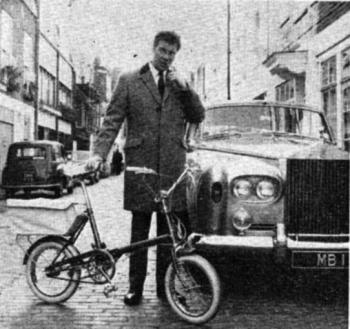
Max Bygraves with an RSW Compact
For the purposes of our road test we got a fit young fellow
who foolishly volunteered to give his all, while we tracked his
performance from the relaxing comfort of the pace
vehicle…
First gear (a frantic effort) 12mph. Second gear (furious
pedalling) 16mph. Third
gear (giving all and getting red in the face) 22mph.
It was commented by our rider that the RSW felt to be quite
hard work to pedal in comparison to a conventional modern
bicycle, so it looks as if the period criticisms of its cycling
efficiency may well have been justified. It seems more
practical to keep the tyres firmly pumped up, and to use the bike
best at a steady and economical pace, after all, it’s a
trendy shopper—not a racer!
One particularly irritating aspect worthy of observation was
that trying to back the bike with the side stand down would cause
the left-hand pedal to rotate backward, and lock solid against
the stand. The bike would always come to a very firm stop,
invariably resulting in some suitable cursing, then requiring
forward pedal rotation to clear the jam.
Popular success of the RSW16 significantly ate into
Moulton’s sales, driving the new company into financial
difficulties, resulting in Raleigh buying the Moulton business,
then finding itself building both types of small-wheeled
bicycles.
Raleigh continued production of the RSW until 1974, by which
time sales of small-wheeled bicycles had slowed to a
trickle—the trendy fashion had fizzled out! The
‘16’ was discontinued after reportedly selling some
100,000 models over nine years, but it’s slightly larger
and more popular RSW20 version endured well into the 1980s.
A new Alex Moulton company continues to manufacture and sell
specialist small-wheeled cycles today.


Chapter 2: Raleigh Wisp—The Chicken or the
Egg?
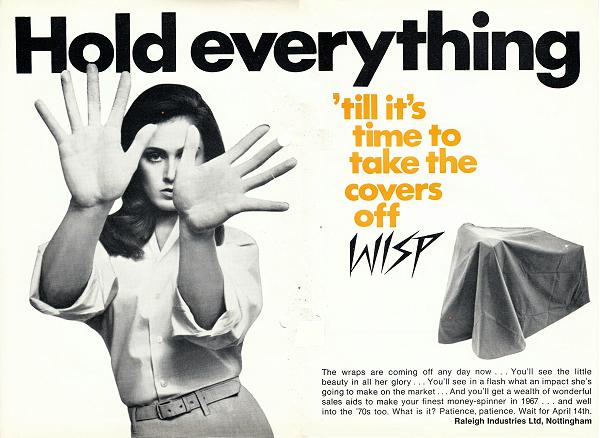
Even before the introduction of the
RSW16, somebody at Raleigh had also come up with the idea to
motorise the new small wheel bicycle by fitment of an engine that
was already being licensed from Motobécane, as had been
introduced in the RM4 from February 1961, and continued into the
RM6 Runabout from May 1963.
The project to produce a motorised version of the RSW16
bicycle was coded RM7, and we can get some idea when this started
because the engine specification was entered as 1.4bhp, as taken from the continuous-fin,
6.5:1 compression motor used in the RM6 at the time, and up to
November 1965 when the early engine would be wholly succeeded by
the new replacement split-fin 7.5:1 compression, 1.7bhp engine.
The RM7 code was allocated to the motorised RSW16 project
before or at the same time as the RM8 Runabout project was
issued. The RM7 model required somewhat more involved
development than the simple RM8 Runabout, which was announced and
introduced in December 1963, so the RM7 project must also have
been commissioned in 1963.
It’s easy to presume that the RM7 may have simply
involved bolting an engine into the RSW16 cycle frame, but the
physical mechanics don’t quite work like that. The
RM7 looked very similar to the bicycle, but actually employed a
completely different frame with reinforced sections at all its
joints.
Development of the RM7 was taking much longer than expected,
as the RM9 was introduced in April 1964, and the RM12 Sports-50
from June 1965, then the RM11 Super Tourist from January
1966.
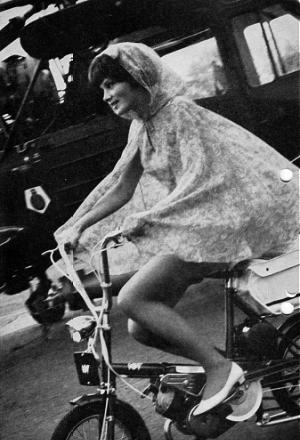 The earliest ‘D’-registered factory
prototype RM7s were completed and running around on
pre-production road tests from summer 1966 (JAU 70D), and
early ‘E’-registered examples (after August 1966), at
which time the models were already branded by a Wisp graphic.
The earliest ‘D’-registered factory
prototype RM7s were completed and running around on
pre-production road tests from summer 1966 (JAU 70D), and
early ‘E’-registered examples (after August 1966), at
which time the models were already branded by a Wisp graphic.
The new moped was introduced on April 14th 1967 priced at 57
guineas (£59–17s–0d), but Raleigh never
officially referenced back to the original RM7 project
designation, and only ever called the machine
‘Wisp’.
The launch promotions and publicity material for the Wisp were
particularly iconic, with a ‘symbol of innovation’
sculpture piece commissioned by Raleigh Industries for
‘Wisp’, incorporating the letters R and W.
There was a classically famous photo-shoot with the fashion model
‘Twiggy’ (Lesley Hornby) riding a Wisp. A
fantastic 16-page colour printed sales booklet that is now
considered as highly collectable literature, and accompanied by a
series of punchy advertisements in newspapers, magazines, and the
motor cycling press. A rhinestone studded Wisp was
decorated to tour the circuit of promotional events, and
Pathé Newsreel filmed two lady models riding Wisps at
Kenley RAF Station, Surrey
(2½ minute video and stills available).
With all the old continuous-fin 6.5:1 compression,
1.4bhp engines finally
used up back in November 1965, production Wisps in 1967 were
fitted with the newer replacement split-fin, 7.5:1 compression
engine rated 1.7bhp.
Published specification data for Wisp however, mistakenly
returned the original 1.4bhp rated information, which was
subsequently interpreted that its performance had been restricted
by fitment of the special inlet manifold cast by Raleigh to
maintain the carb float bowl level due to Wisps greater
inclination engine mounting.
Though the special Wisp manifold reduces this inlet bore to
3/8" (9.52mm) from the AR10mm
Gurtner carburettor, this tiny change certainly wouldn’t
wipe off 0.3bhp from a
1.7bhp motor.
The Wisp was mainly only produced in two colours, Fiesta Blue
& Spanish Gold, though the rhinestone studded Wisp was
finished for marketing promotional purposes, and some white ones
were reportedly produced later in the run, but we’ve never
seen any.
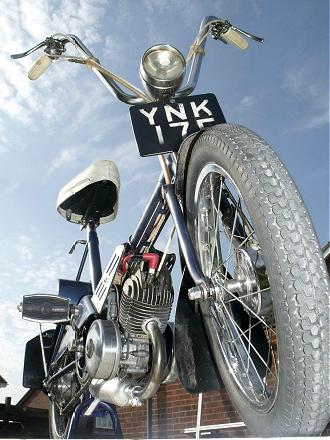 Our
first tester, registered on 27th September 1967 is a Fiesta Blue
Wisp trimmed with white cables, saddle cover, carrier box, and
handle grips, showing frame number 016420, and fitted with
original specification 44-tooth rear sprocket.
Our
first tester, registered on 27th September 1967 is a Fiesta Blue
Wisp trimmed with white cables, saddle cover, carrier box, and
handle grips, showing frame number 016420, and fitted with
original specification 44-tooth rear sprocket.
To start Wisp, there’s a little petrol tap
‘key’ that inserts through a hole in the left-hand
engine cover just below the petrol tank. Though the
‘key’ is removable, that function is only intended to
enable the cover to be removed, which wouldn’t be possible
with the ‘key’ permanently fixed in place as part of
the fuel tap. It isn’t really practical to use this
as any security device to disable the fuel supply since it
isn’t so easy to relocate the extended shaft back into the
petrol tap socket, and requires rotation of the flat on the shaft
to feel into alignment with the flat in the tap, then push in to
click home.
Turning the key clockwise through 90° turns on the main
tank, and a further 90° clockwise to the stop gives reserve
supply.
Turn the throttle twistgrip forward to decompress, pull in the
trigger choke under the left-hand bar, firmly kick the pedal to
spin the motor and twist the throttle open at the same
time. If you’re lucky the motor might catch. If
not, then pedal up the road (we don’t really recommend
pedal-starting on the stand since this is usually what’s
responsible for lots of ruined moped centre stands).
Apart from an initial flat-spot when the clutch shoes engage
the drive, acceleration from a standstill proved quite
reasonable, though it was very quickly obvious that this was
because the bike appears dramatically under-geared, and achieving
only 22mph (paced) along the
flat. The bike further slowed to 19mph against a light uphill gradient,
which rather surprised us since we thought the low drive ratio
would allow it to climb the incline without dropping any pace,
but not so—never underestimate the power of gravity!
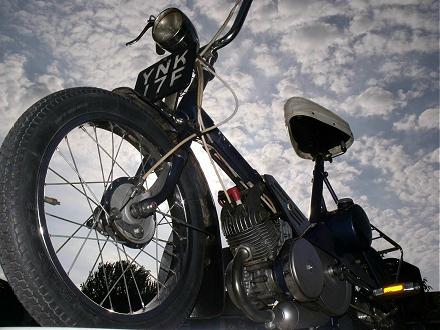 Downhill run 25mph, but this was ridiculously
over-revving. Vibrations through the seat were akin to
receiving an electric shock, and were so uncomfortable that you
really didn’t want to be sitting on the sprung ‘super
comfort’ foam padded-saddle. Within a few hundred
yards at this speed, it felt as if you’d been injected with
anaesthetic! This was a level of vibration that crossed the
pain threshold. No wonder it’s common to find so many
cracked number plates and mudguards on Wisps!
Downhill run 25mph, but this was ridiculously
over-revving. Vibrations through the seat were akin to
receiving an electric shock, and were so uncomfortable that you
really didn’t want to be sitting on the sprung ‘super
comfort’ foam padded-saddle. Within a few hundred
yards at this speed, it felt as if you’d been injected with
anaesthetic! This was a level of vibration that crossed the
pain threshold. No wonder it’s common to find so many
cracked number plates and mudguards on Wisps!
The riding experience wasn’t quite as claimed in the
sales booklet, which stated ‘Beats 25mph without any fuss. Feels great
all the time’—that’ll be artistic license
then.
In January 1968 the rear sprocket was changed to 36-tooth to
address dealer and customer complaints of over-revving causing
engine failure, and excessive vibration. The Wisp frame was
also reportedly modified at this time with an increased angle on
the head tube and the handlebars altered to suit the new
angle.
Considering that the rear sprocket change raised the final
drive ratio by over 18%, it’s easy to appreciate how
dramatically under-geared the early Wisps were with the original
44-tooth sprocket.
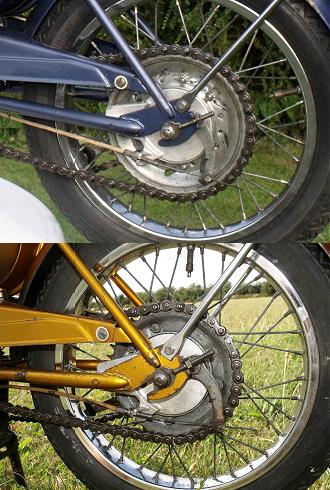 The 44-tooth rear sprocket was initially fitted,
simply because it was the smallest sprocket available from
Motobécane to fit the Atom hub—but it very clearly
wasn’t at all suitable for the tiny Wisp wheels, and why
Raleigh even went ahead with putting out production bikes with
such a dramatically low drive ratio that could so easily over-rev
their engines, was a total mystery.
The 44-tooth rear sprocket was initially fitted,
simply because it was the smallest sprocket available from
Motobécane to fit the Atom hub—but it very clearly
wasn’t at all suitable for the tiny Wisp wheels, and why
Raleigh even went ahead with putting out production bikes with
such a dramatically low drive ratio that could so easily over-rev
their engines, was a total mystery.
Raleigh had to make the 36-tooth sprocket themselves as a
special.
Considering that the RM6 Runabout, fitted with the same engine
and using the same 44-tooth rear sprocket, drives 23" diameter
wheels to the Wisp’s 16", then the original Wisp seemed to
be running a 30.5% lower drive ratio!
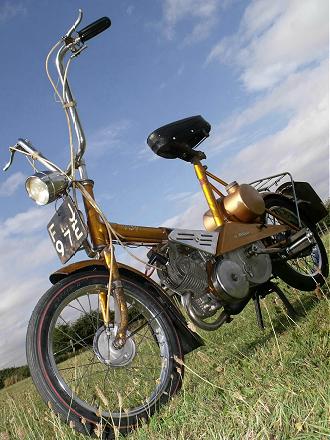 Our
second tester is a Spanish Gold Wisp, which colour scheme was
trimmed with the same white cables, though black saddle cover,
carrier box, & handle grips. Fitted with the smaller
36-tooth rear sprocket and registered in 1968, this would appear
to be a ‘new specification’ manufacture, but with
frame number 012376, this appears to be a lower serial than our
first 44-tooth tester, so we’re a little confused how
Raleigh’s frame numbering was working on these
machines? Our conclusion is that this bike might have been
retrospectively fitted with the smaller 36-tooth sprocket to
resolve its revving and vibration issues.
Our
second tester is a Spanish Gold Wisp, which colour scheme was
trimmed with the same white cables, though black saddle cover,
carrier box, & handle grips. Fitted with the smaller
36-tooth rear sprocket and registered in 1968, this would appear
to be a ‘new specification’ manufacture, but with
frame number 012376, this appears to be a lower serial than our
first 44-tooth tester, so we’re a little confused how
Raleigh’s frame numbering was working on these
machines? Our conclusion is that this bike might have been
retrospectively fitted with the smaller 36-tooth sprocket to
resolve its revving and vibration issues.
Both our feature bikes mounted the ‘super comfort’
pad-saddle, which hinges from the front, with a shock absorbing
compression spring between the back of the base and the saddle
mounting frame clamped to the seat post.
Another un-sprung version of the ‘super comfort’
pad-saddle was also sold as an accessory for Raleigh RM6, RM8,
and RM9
Rather than simply being mounted ‘flat’ as the
un-sprung ‘super comfort’ pad-saddle, insertion of
the spring requires the saddle to be pitched at a suitable
forward angle so it can comfortably sit flat under compression of
the spring with the rider mounted.
Starting procedure was exactly the same as the earlier model,
and pulling off from a standstill, you notice the gearing
difference straight away. There’s now a big flat-spot
as the clutch shoes engage the drive, and the motor labours hard
against the higher ratio. It’s easy to imagine that
there might now be some circumstances where the bike might
appreciate some pedal assistance in pulling away.
Acceleration is obviously slowed by the ratio change, but it
does make a huge difference to the Wisp. The engine revs
are much more leisurely, considerably reducing vibration, and
making the whole riding experience a lot more comfortable for mid
range cruising.
While the final drive gearing has been raised by over 18%,
this doesn’t seem to translate directly into 18% more speed
for our test mount, which burbles along quite happily, but seems
too docile to achieve anywhere near the kind of screaming revs
our earlier under-geared example achieved. Possibly our
brief test run being its first outing following 25 years in the
back of a lock-up garage wasn’t enough to clear the
cobwebs, but the pace results were a little disappointing.
It just didn’t seem quite ready to get-up-and-go.
 23mph along the
flat, dropping back to 19 on uphill climb, and 25 downhill.
Little difference really to the earlier low-ratio version, but a
whole lot more comfortable to ride.
23mph along the
flat, dropping back to 19 on uphill climb, and 25 downhill.
Little difference really to the earlier low-ratio version, but a
whole lot more comfortable to ride.
Theoretically achieving the same revs should have expected
26mph along the flat and 29 downhill, but this example proved a
little off the pace for its top speed.
At the end of June 1969, Raleigh’s owners Tube
Investments delivered the bombshell news to its employees of the
Motorised Division that they were all on three months’
notice of redundancy, and that all powered products were to be
dropped. Introduced 14th April 1967, Wisp production
officially ended in September 1969, along with the RM5
Supermatic, RM8 Automatic MkII, RM9 Ultramatic, and RM9+1
(RM10).
With a revised frame numbering system, only the faithful RM6
Runabout soldiered on to burn off stocks, until January 1971,
when the last Raleigh moped officially disappeared from the
lists.
After some four years in development, the iconic Wisp had been
in production for a mere 2½ years.
So what came first, the chicken or the egg? Neither
actually—The RSW16 bicycle and RM7 Wisp were conceived at
exactly the same time, somewhere back in 1963 when Raleigh were
deciding on a way to reply to Alex Moulton’s small-wheel
bicycle. It’s just that the RSW16 bicycle was
completed for sale first in 1965, while the Wisp moped required
more development, so consequently wasn’t launched until
1967.
Next—An ancient name, returning back from the
pioneering dawn of motor cycling, though strangely, one of our
most difficult research projects to track, since so little ever
seems to have been published about them!
It’s been particularly hard piecing together all the
various fragments of related history scattered over an incredible
137 years. This project research file was actually started
in April 2006, way back before we’d even started
IceniCAM!
You want a clue what the bike may be? Who takes 46 years
to build a moped? Return of the New
King.
This article appeared in the January 2016 Iceni
CAM Magazine.
[Text & photographs © 2016
M Daniels.]
Making The Chicken or the Egg?
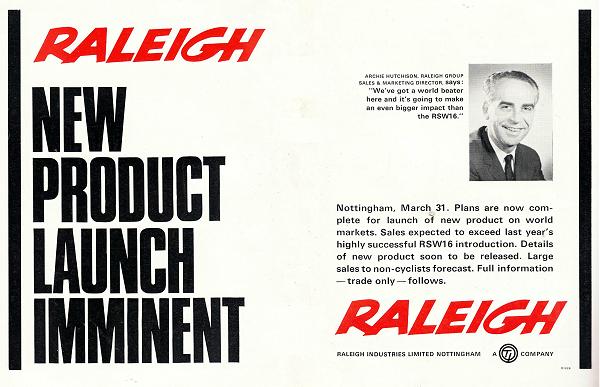
The concept and structure of our
Raleigh Wisp article was formulated quite some time back, and was
planned with the intention of creating a definitive and fully
comprehensive production.
Since the Wisp technical specification was revised after its
first season to address the over-revving and subsequent engine
failure & vibration issues, we would be needing standard
models in each configuration.
The Wisp was only sold in the two metallic colours of Fiesta
Blue and Spanish Gold, so we would also ideally be wanting two
bikes, both in original factory finishes for the photoshoot.
Being primed with a reflective aluminium base coat, then
coloured with a translucent topcoat, makes the original metallic
finishes of the Wisp particularly difficult to reproduce
properly, and most seem to become repainted in either a standard
block blue or some proprietary gold, which rarely look anything
like the original finish.
Since presenting the correct colours was considered so
important for the photoshoots, we decided that only good original
paintwork would suffice, which instantly ruled out a lot of the
available examples.
Our first and most promising opportunity came in summer 2012
when the workshops bought in a brace of bikes from Hemel
Hempstead, as a ‘his & hers’: a 1964 80cc Suzuki
K10 and a 1967 Fiesta Blue Raleigh Wisp in early 44-tooth
configuration.
Of the two bikes, the Raleigh Wisp was actually processed
first and, as an obviously low mileage machine, restored to
fantastic original condition. This represented a great
example to get our article started, but the road test proved an
horrendous experience, with screaming revs and shattering
vibration due to the original undergeared 44-tooth low drive
ratio.
You instantly appreciated how Wisps’ first customers
must have felt—it was dreadful!
Having got the blue Wisp road test & photoshoot completed
in August 2012, the bike was very quickly sold on.
The workshops then set about restoring the Suzuki K10, which
was subsequently completed for RT&PS in April 2013, but
didn’t appear in the Thin End of the Wedge article
until in January 2015.
The Wisp project had meanwhile gone into mothballs awaiting
the availability of a later specification Spanish Gold example
with 36-tooth rear sprocket. You’d think this should
be a fairly easy demand to satisfy, since there are lots of Wisps
around, but it seems funny how you can never find exactly what
you want when you’re after something so specific.
It wasn’t until August 2014 when we were at the West
Anglian section’s Shuttleworth Shuffle event based at
Moggerhanger village hall, that we diverted to the outskirts of
Milton Keynes after the event, to collect another 1969 Wisp that
the workshops had done a deal to buy in.
This machine proved to be the correct original Spanish Gold
colour and later 36-tooth specification we were looking
for—but what a derelict! 25 years storage in the back
of a lock-up garage had certainly taken its toll.
This was going to take an awful lot of fixing …
there was a major worklist for this bike and the rotted petrol
tank had to be replaced & repainted.
It was July 2015 before this Wisp rolled out of the workshops
for RT&PS,
and again, our second Wisp was shortly sold on after its purpose
had been fulfilled.
Meanwhile, towards the last months of 2014, the workshops had
also acquired a promising and obviously minimal-use
RSW16 MkII bicycle that required some work and new tyres,
but was clearly too good not to save—so now we had the
opportunity to add a third element to our Wisp feature.
The RSW16 was fixed up for RT&PS in January 2015,
then shortly sold on to the same buyer of our Kieft KS50 from the
Racing Heritage feature in our last
edition of October 2015. When Norman Crawford bought the
Kieft and RSW16, he also made a donation to sponsor the KS50
article, but we’d ‘misplaced’ his details at
the crucial moment when the credits were being attached, so
Norman ended up sponsoring his RSW16 instead.
All articles are initiated as individual text files on
RT&PSs, so
the Wisp file started from notes on the Fiesta Blue bike, then
the Spanish Gold notes were added on later, and the file
subsequently collated with related research notes from
there. Much of this text was developed and written up while
Danny was in Malta during September 2015; in fact most of
IceniCAM edition 36 was drafted over this week in the
Mediterranean, so we were actually well ahead of the game for a
change this time.
The RSW16 file was separately developed from its own
individual file, so by the time we’d decided to present the
RSW and Wisp features in the same article, they’d already
evolved as separate entities. Instead of engaging in a
complete re-write to blend both text files together, it was
decided to produce the article in two distinct chapters.
This unusual structure however, seemed to work out quite
naturally for this particular feature, since Raleigh launched the
bicycle so quickly in 1965, while the RM7 motorised version
wasn’t completed until a whole two years later.
Not until all the various Raleigh project timings were
collated, could it really be appreciated that the RSW16 bicycle
and Wisp were actually initiated at the same time in 1963, while
everyone had always presumed that the Wisp had evolved later as a
development of the bicycle.
Several titles for the RSW/Wisp article were toyed with, but
From Cycle to Moped & The Chicken or the Egg? seemed most appropriate for
the time honoured question of which came first?
Raleigh marque specialist Les Gobbett has had a long-standing
sponsorship credit lodged with us for another Raleigh article,
and it’s certainly taken a while to work this Wisp feature
to completion: 3½ years in fact! We felt it was
particularly important being patient enough to get all the
article details absolutely right in the end, to finally present
such a worthwhile and definitive reference piece about the Wisp
moped.

 This tale has to start
with a chap called Alex Moulton, an aircraft engineer, who came
up with designs in the late 1950s to produce small-wheeled
bicycles. He approached Raleigh with the idea, but
negotiations broke down, so he formed his own company as Moulton
Bicycles Ltd and established a factory at Bradford-on-Avon,
to begin building bicycles himself.
This tale has to start
with a chap called Alex Moulton, an aircraft engineer, who came
up with designs in the late 1950s to produce small-wheeled
bicycles. He approached Raleigh with the idea, but
negotiations broke down, so he formed his own company as Moulton
Bicycles Ltd and established a factory at Bradford-on-Avon,
to begin building bicycles himself.





 The earliest ‘D’-registered factory
prototype RM7s were completed and running around on
pre-production road tests from summer 1966 (JAU 70D), and
early ‘E’-registered examples (after August 1966), at
which time the models were already branded by a Wisp graphic.
The earliest ‘D’-registered factory
prototype RM7s were completed and running around on
pre-production road tests from summer 1966 (JAU 70D), and
early ‘E’-registered examples (after August 1966), at
which time the models were already branded by a Wisp graphic. Our
first tester, registered on 27th September 1967 is a Fiesta Blue
Wisp trimmed with white cables, saddle cover, carrier box, and
handle grips, showing frame number 016420, and fitted with
original specification 44-tooth rear sprocket.
Our
first tester, registered on 27th September 1967 is a Fiesta Blue
Wisp trimmed with white cables, saddle cover, carrier box, and
handle grips, showing frame number 016420, and fitted with
original specification 44-tooth rear sprocket. Downhill run 25mph, but this was ridiculously
over-revving. Vibrations through the seat were akin to
receiving an electric shock, and were so uncomfortable that you
really didn’t want to be sitting on the sprung ‘super
comfort’ foam padded-saddle. Within a few hundred
yards at this speed, it felt as if you’d been injected with
anaesthetic! This was a level of vibration that crossed the
pain threshold. No wonder it’s common to find so many
cracked number plates and mudguards on Wisps!
Downhill run 25mph, but this was ridiculously
over-revving. Vibrations through the seat were akin to
receiving an electric shock, and were so uncomfortable that you
really didn’t want to be sitting on the sprung ‘super
comfort’ foam padded-saddle. Within a few hundred
yards at this speed, it felt as if you’d been injected with
anaesthetic! This was a level of vibration that crossed the
pain threshold. No wonder it’s common to find so many
cracked number plates and mudguards on Wisps! The 44-tooth rear sprocket was initially fitted,
simply because it was the smallest sprocket available from
Motobécane to fit the Atom hub—but it very clearly
wasn’t at all suitable for the tiny Wisp wheels, and why
Raleigh even went ahead with putting out production bikes with
such a dramatically low drive ratio that could so easily over-rev
their engines, was a total mystery.
The 44-tooth rear sprocket was initially fitted,
simply because it was the smallest sprocket available from
Motobécane to fit the Atom hub—but it very clearly
wasn’t at all suitable for the tiny Wisp wheels, and why
Raleigh even went ahead with putting out production bikes with
such a dramatically low drive ratio that could so easily over-rev
their engines, was a total mystery. Our
second tester is a Spanish Gold Wisp, which colour scheme was
trimmed with the same white cables, though black saddle cover,
carrier box, & handle grips. Fitted with the smaller
36-tooth rear sprocket and registered in 1968, this would appear
to be a ‘new specification’ manufacture, but with
frame number 012376, this appears to be a lower serial than our
first 44-tooth tester, so we’re a little confused how
Raleigh’s frame numbering was working on these
machines? Our conclusion is that this bike might have been
retrospectively fitted with the smaller 36-tooth sprocket to
resolve its revving and vibration issues.
Our
second tester is a Spanish Gold Wisp, which colour scheme was
trimmed with the same white cables, though black saddle cover,
carrier box, & handle grips. Fitted with the smaller
36-tooth rear sprocket and registered in 1968, this would appear
to be a ‘new specification’ manufacture, but with
frame number 012376, this appears to be a lower serial than our
first 44-tooth tester, so we’re a little confused how
Raleigh’s frame numbering was working on these
machines? Our conclusion is that this bike might have been
retrospectively fitted with the smaller 36-tooth sprocket to
resolve its revving and vibration issues. 23mph along the
flat, dropping back to 19 on uphill climb, and 25 downhill.
Little difference really to the earlier low-ratio version, but a
whole lot more comfortable to ride.
23mph along the
flat, dropping back to 19 on uphill climb, and 25 downhill.
Little difference really to the earlier low-ratio version, but a
whole lot more comfortable to ride.